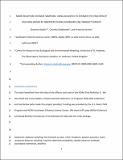Files in this item
Mark recapture distance sampling : using acoustics to estimate the fraction of dolphins missed by observers during shipboard line-transect surveys
Item metadata
| dc.contributor.author | Rankin, Shannon | |
| dc.contributor.author | Oedekoven, Cornelia Sabrina | |
| dc.contributor.author | Archer, Frederik | |
| dc.date.accessioned | 2021-04-03T23:41:30Z | |
| dc.date.available | 2021-04-03T23:41:30Z | |
| dc.date.issued | 2020-06 | |
| dc.identifier | 267284919 | |
| dc.identifier | 1dad6413-47c7-48db-9d41-b3bebfb9117c | |
| dc.identifier | 000523392500001 | |
| dc.identifier | 85084642419 | |
| dc.identifier.citation | Rankin , S , Oedekoven , C S & Archer , F 2020 , ' Mark recapture distance sampling : using acoustics to estimate the fraction of dolphins missed by observers during shipboard line-transect surveys ' , Environmental and Ecological Statistics , vol. 27 , no. 2 , pp. 233–251 . https://doi.org/10.1007/s10651-020-00443-7 | en |
| dc.identifier.issn | 1352-8505 | |
| dc.identifier.other | ORCID: /0000-0002-5610-7814/work/71955014 | |
| dc.identifier.uri | https://hdl.handle.net/10023/21768 | |
| dc.description | Funding: U.S. Navy’s N45 Program and NOAA Southwest Fisheries Science Center. | en |
| dc.description.abstract | Cetacean abundance estimation often relies on distance sampling methods using shipboard visual line-transect surveys, which assumes that all animals on the trackline are detected and that the detection of animals decreases with increasing distance from the trackline. Mark–Recapture Distance Sampling (MRDS) typically employs a secondary visual observation team and may be used to identify the fraction of animals detected on the trackline when it is suspected that animals may have been missed. For species that are difficult to detect using visual observation methods, such as deep-diving species or those with cryptic surfacing behavior, this secondary team may be prone to the same limitations in detection as the primary observation team and alternative modes of detection may improve estimates. Here we examine the potential use of passive acoustic detection as a secondary platform for MRDS of rough-toothed dolphins (Steno bredanensis) during a combined visual and acoustic shipboard line-transect survey. The average trackline detection probability for rough-toothed dolphins was less than one for both the trial configuration (average p(0)=0.45 for the visual team) and independent observer configuration (average p(0)=0.37 for the visual, p(0)=0.77 for the acoustic and p(0)=0.84 for both teams combined). This study, while limited in scope, strongly suggests that passive acoustic methods may be an effective alternative for estimating p(0) for some cetaceans species. | |
| dc.format.extent | 19 | |
| dc.format.extent | 766764 | |
| dc.language.iso | eng | |
| dc.relation.ispartof | Environmental and Ecological Statistics | en |
| dc.subject | Abundance estimation | en |
| dc.subject | Distance sampling | en |
| dc.subject | Dolphins | en |
| dc.subject | Double observer methods | en |
| dc.subject | Line-transect surveys | en |
| dc.subject | Mark–recapture | en |
| dc.subject | Mark–recapture distance sampling | en |
| dc.subject | Passive acoustics | en |
| dc.subject | Trackline detection probability | en |
| dc.subject | GC Oceanography | en |
| dc.subject | QA Mathematics | en |
| dc.subject | DAS | en |
| dc.subject | BDC | en |
| dc.subject.lcc | GC | en |
| dc.subject.lcc | QA | en |
| dc.title | Mark recapture distance sampling : using acoustics to estimate the fraction of dolphins missed by observers during shipboard line-transect surveys | en |
| dc.type | Journal article | en |
| dc.contributor.institution | University of St Andrews. School of Mathematics and Statistics | en |
| dc.contributor.institution | University of St Andrews. Centre for Research into Ecological & Environmental Modelling | en |
| dc.identifier.doi | https://doi.org/10.1007/s10651-020-00443-7 | |
| dc.description.status | Peer reviewed | en |
| dc.date.embargoedUntil | 2021-04-04 |
This item appears in the following Collection(s)
Items in the St Andrews Research Repository are protected by copyright, with all rights reserved, unless otherwise indicated.

